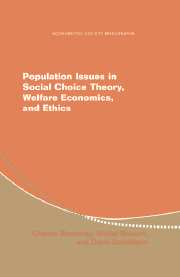Book contents
- Frontmatter
- 1 Introduction
- 2 Measurement of Individual Well-Being
- 3 Welfarist Social Evaluation
- 4 Fixed-Population Principles
- 5 Population Principles
- 6 Characterizations and Possibilities
- 7 Uncertainty and Incommensurabilities
- 8 Independence of the Existence of the Dead
- 9 Temporal Consistency
- 10 Choice Problems and Rationalizability
- 11 Applications
- References
- Author Index
- Subject Index
8 - Independence of the Existence of the Dead
Published online by Cambridge University Press: 05 January 2013
- Frontmatter
- 1 Introduction
- 2 Measurement of Individual Well-Being
- 3 Welfarist Social Evaluation
- 4 Fixed-Population Principles
- 5 Population Principles
- 6 Characterizations and Possibilities
- 7 Uncertainty and Incommensurabilities
- 8 Independence of the Existence of the Dead
- 9 Temporal Consistency
- 10 Choice Problems and Rationalizability
- 11 Applications
- References
- Author Index
- Subject Index
Summary
Part A
In this and the following chapter, we use an explicit intertemporal structure for variable-population social evaluation. Nonwelfare information includes the birth dates and lifetimes of those alive in each alternative and all other nonwelfare information is assumed to be fixed. We examine the consequences of weakening Pareto indifference and strong Pareto so that birth dates or lifetimes (or both) may matter. In addition, we impose a natural independence condition, called independence of the existence of the dead, that requires the ranking of any two alternatives to be independent of the existence of individuals whose lives are over and who had the same lifetime utilities, birth dates, and lifetimes in both alternatives.
AN INTERTEMPORAL ENVIRONMENT
To investigate population principles in an intertemporal setting, we employ a period analysis with arbitrary period length. There are multiple information profiles that provide, for each possible person, lifetime utility, birth date, and length of life in each alternative in which the person is alive. Other nonwelfare information, which is assumed to be fixed, can be disregarded, as in the case of a single nonwelfare-information profile. We assume that no person can live more than a fixed number of periods. The maximal lifetime is finite but can be arbitrarily large.
Information about a possible alternative is displayed in Table 8.1. In it, individuals 2, 21, 1,024, and 1,729 are alive in periods 4 to 9, 1 to 6, 7 only, and 3 to 5, and their lifetime utilities are 70, 25, 0, and 22. In the problems investigated in this chapter, it is not necessary to assign individual utility values to the periods themselves; all that is needed is lifetime utility.
- Type
- Chapter
- Information
- Publisher: Cambridge University PressPrint publication year: 2005



